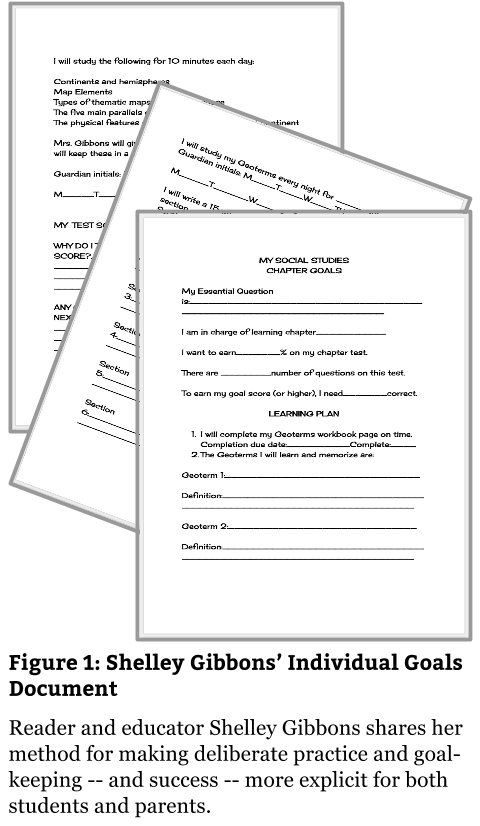In “The Kind of Science that Teaching Needs,” I shared an “experiment” I whipped up last year to help my students set and stay committed to their goals. If you read that article, you'll know that I have to put “experiment” in quotation marks because it was missing a few important pieces of experimentation (like, you know, a measurement method or a hypothesis). However, if you watched the video that accompanied the experiment, you know that a lot of my students were struggling to carry out their goals from week to week (the video is here in case you missed it).
Thankfully, that article prompted reader, Stuart cousin (!), and educator Shelley Gibbons to write me with a goal-setting exercise (see Fig. 1; free download instructions below that) that she has found works well with students. I'll let her take it away from here, and then I'll suggest a few ways that this document could be tweaked to fit a variety of contexts.
Shelley Gibbons' Highly Adaptable, Beautifully Specific “Social Studies Individual Goals Document”
Hi Dave,
I just read your article on the science of teaching, and thought I would pass this goals document I created last year along to you.
I noticed from your video that a number of your students were having difficulty following through on their goals. I've found that sixth graders and ninth graders need to team up with their parents to achieve success, because entering a new school is such a transitional time.
Both my students and parents liked the concrete format of this learning goals document. It helped parents to know what their children needed to study, and it laid the learning process out for the students in do-able increments. My class average on tests went up 10%. You'll notice that I also have a reflection piece at the end of this form. My students received completion grades of a few points for having their parent's initials on the form, and they knew I would be checking these. This further helped with accountability on their part.
I'm not sure what social studies curriculum you use. I use Geography Alive! from TCI, so this form is geared specifically to that program. Please feel free to make a copy and change the format of this document to go along with your curriculum if you choose to use it.
Keep up the good work!
Shelley
Download instructions for Shelley's document
You can access Shelley's goals document through the links below. I've made it available in three formats:
- Google Docs
- A Note on Google Docs Sharing: If you choose the Google Docs version, you need to File > Make a Copy if you want to edit it. Also, sometimes folks' school districts have weird settings on Google Apps, so you may not be able to access it at school. Finally, if for any reason the Google Docs version isn't working for you, please know that I can't respond to “Share” requests through Google Docs. My articles of the week page already produces dozens of Share requests per day, and I don't try keeping up with them anymore — mainly because all of my docs are set to “Anyone with the link can view,” which means you can access and File > Make a Copy of any of them that you'd like.
- Microsoft Word (.docx)
- Read-only file (.pdf)
Concluding thoughts and recommendations from Dave
Part of the document's genius is how specific it is to Shelley's class. Yet because of that, I'd be shocked if it worked, exactly as is, in your class. Some words from Shelley:
Tests need to be created and assigned points determined before students are given each study unit's goal document. The teacher will need to share the amount of points possible for students to determine how many questions they need to have correct to attain their percentage goal. (A little math practice thrown into the mix… kind of like hiding vegetables in a spaghetti sauce.)
If you can, measure this document's effect on student performance this year. Notice that Shelley was able to demonstrate a 10 percent increase in test scores. That's significant.
The tool is useful for building the school-parent partnership. Shelley explains the goal-setting routine to parents at the start of the year, and parents know to look for the sheet at the start of each chapter. Not all of your students' parents may use the document, but remember: we're not looking for silver bullets, just swords for combatting the dragon of school-home disconnect.
This tool isn't just for academically at-risk kids; it's for making success explicit to all of our kids. From Shelley:
I originally intended to create this goals document for some of my academically struggling students. I knew that I needed to break down exactly what to study to improve their learning (and thereby grades) into bite-sized portions, but decided to extend this activity to all of my students. Goal setting is such an important life skill, but my sixth graders needed a road map and some parental input to meet those goals. [1]
Adapt, adapt, adapt.
Shelley's document merited sharing because of how well it's suited to her setting and because of the ways it gets my mind running. How can I make success more explicit for my students this school year? I suspect that doing this will result in more students owning their learning, thereby leading to more long-term flourishing.
Footnote:
- In addition to being a core component of grit, goal-setting is a component of Dr. David Conley's Ownership of Learning skill, “Progress Monitoring.” (Read more about Conley's “Four Keys” model of career and college readiness in his book.) [hr]
Thank you to Shelley Gibbons for letting me share this with the community of educators who come to this blog for help and encouragement. All the best to you, your family, and your students this school year, Shelley!

Leave a Reply